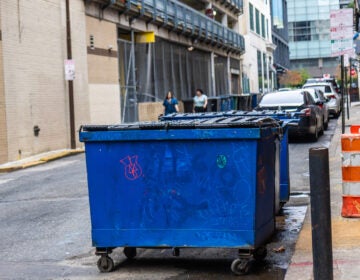Tulpehocken Station is finally shaping up
Jeff Smith of Germantown has an old postcard that shows a steam engine chugging to a stop at an idilic looking train station, where a woman in a hat awaits. The post mark is 1906.
That rather perfect station is the one at the end of Tulpehocken Street in Germantown on SEPTA’s Chestnut Hill West line. The hand written note on the card proudly declare’s “our station.” The card was sent as a thank you for a dinner invitation.
To cynics, that may well have been the last time Tulpehocken Station was featured as a thing of beauty. Even though the stop remained popular, SEPTA left the building virtually untouched for decades. So long in fact, that the roof began to rot through and portions of the building started to fall away.
It became particularly frustrating to station advocates in 2008 when SEPTA announced more than $13 million in capital projects on the Chestnut Hill West line, primarily at Queen Lane and Allen Lane stations, and the only thing allotted to Tulpehocken was a tarp to cover the gaping holes in the roof.
Nearly three years later, after much work from advocates like Smith and his Tulpehocken Station Committee, and federal stimulus awards from last year, the story has turned around. SEPTA allocated $689,000 to Tulpehocken from its nearly $200 million in stimulus funds.
Construction by general contractor Lorenzon Brothers Company has been moving slowly, says Smith, but it’s something. Better than something – it’s saving the station.
“Initially, the project was to be completed by now,” he wrote in an email. “But March was the estimate last November. Given the weather and they way they work, it looks like it could be April before it’s done. But it will look and be great structurally.”
SEPTA estimates the project is now 65 percent complete, according to its Web site.
The work at Tulpehocken is restricted to stabilizing the building, and doing so within the confines of historical preservation guidelines. That means a new roof, roof timbers and complete repairs to the building shell and main structure to reverse its long decay. And it means making those repairs consistent with the style of 1880s construction – the building’s apparent pedigree.
Once the project is done SEPTA hopes to lease the station to a private business to generate rent and breath some life back into it again.
But there are still challenges. Since the project only covers the outside of the building, any leasing company would have to take on a total interior renovation and electrical and mechanical systems upgrade, likely an expensive prospect. Smith and the Tulpehocken Station Committee are already looking into preservation grants to give that phase of the work a jump start.
This is a corrected version of this article. The original version had incorrect information about federal stimulus funds.
The slideshow below is courtesy of Jeff Smith.
WHYY is your source for fact-based, in-depth journalism and information. As a nonprofit organization, we rely on financial support from readers like you. Please give today.




